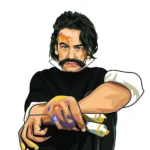Les Abattoirs, a cultural institution in Toulouse that incorporates a museum of modern art, a contemporary arts center, and a regional contemporary arts collection (FRAC in French), is showing a selection of works donated by Mr. Anthony Denney (photographer and decorator), including the famous Battle of Hastings. The exhibition, initially set to run from January 30 through May 3, 2015, will be extended until September.
As the artwork’s label reminds viewers, Georges Mathieu painted this imposing 5 meter by 2 meter canvas in public on June 23, 1956, on a London street:
While the vehemence of his lyricism likens his work to Art Informel, Georges Mathieu prefers to speak of lyrical abstraction, and it was in the revolts staged by the Gutai group that he found the ideal epic thrust for the expression of his passion for History. His large compositions became the battleground for the combat waged by the painter-soldier during his lightning fast creative work. Rapidity of execution becomes an imperious necessity for the desire of physical fusion with the paint, for a subversive and nurturing violence. With his lion’s mane of hair, impressive mustache, and airs of a dandy draped in a variety of suits, the personage of Georges Mathieu was never so fulfilled than during the creation in public of numerous monumental works, from which he came away disheveled, all-consumed, and streaked with paint.
Mathieu painted La Bataille de Hastings (the Battle of Hastings) on June 23, 1956, on a London street between 5:00pm and 6:53pm. The paint is barely out of the tube, then brushed in a powerful gesture, the impulsive and rapid stroke is unleashed like a cavalcade across a landscape-oriented canvas. This simple and confused black, white, red, yellow, gray calligraphy, between implosion and explosion, could tell the story of the Battle of Hastings, or how the Norman William the Conqueror conquered England…
Georges Mathieu, a confirmed monarchist, was a traveler who executed his canvases by infusing them with the erudite history of the different countries he visited.
In all, the Midi-Pyrénées FRAC has four Georges Mathieu works in its collection, including three from 1956 that came from the Anthony Denney collection (La Bataille de Hastings — the Battle of Hastings), Mort d’Ascelin de Rochester — the Death of Ascelin of Rochester, Mathieu d’Alsace se rend au couvent de Ramsay — Matthew of Alsace goes to Ramsay convent), and the fourth, dating from 1970, was acquired from the artist (Entrée de Louis Antoine de Bourbon, Duc d’Angoulême dans Toulouse — the Entry to Toulouse of Louis Antoine de Bourbon, Duke of Angoulême).
Invalid Displayed Gallery






